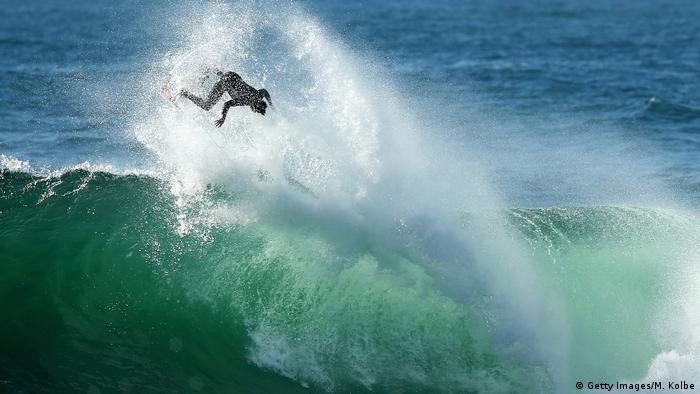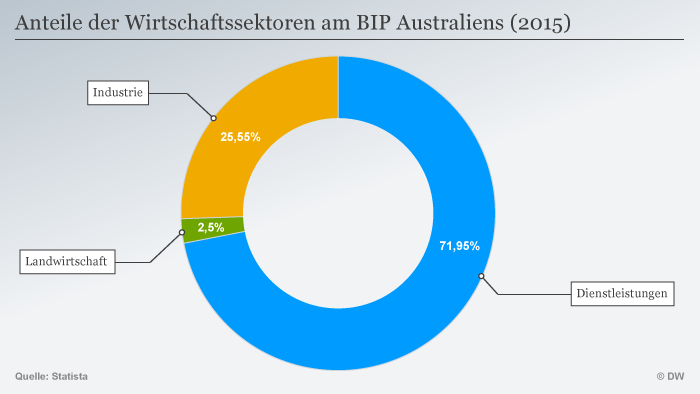More than a quarter of a century on the crest of a Wave – Australia’s economy grows and grows. The shadow pages will be hidden and the course for the future only half-heartedly.

In the market economy, it goes up and down constantly. The economy is recovering from the Economic downturn and swings on to the Boom. Then it’s back down in the recession, which eventually leads into Depression, to the Economic downturn, before it goes up again. It teaches the classical economic theory and so you can watch it again and again. A cycle, as inevitable as on the high seas after a wave crest, the wave trough arrives, even if the length of the wave trough can vary. In Australia, however, this mechanism seems to be broken. For 26 years, the country is swimming without a break at the top, on the crest of a Wave.
Even in 2008, as many countries during the global banking and financial crisis, plunged into the trough of the sea, it was the Australians. Also the decline of commodity prices in 2015, the supernatant Down Under without major wounds. Now, at 30. June, can celebrate the twelfth-largest economy and even a world record. No country has such a long time, been through a recession, so without the economic output shrinks for two quarters in a row

Australia is one of the world’s largest funders of coal
A Generation of happiness
In the past, the Netherlands had held this record. They managed to grow between 1982 and 2008, 103 consecutive quarters. But then the financial crisis ended, your economic luck. The Australians, a quarter more now – despite the financial crisis.
Records are always dependent on the figures. And here it is, as often in Economics, is difficult. Data from the national statistical offices sometimes differ from those of other organizations, such as the world Bank or developed countries-group of OECD. The economic newspaper the Financial Times, comes after an analysis of OECD Figures to the conclusion that the world is kept a record not from Australia but from Japan, its economy in 1960 to a total of 33 years without a recession grew.
Sure, at least, is that Australia enjoys the world’s longest, unbroken phase of growth.
“A Generation of Australians grew up without a recession, is experiencing,” said Australia’s Finance Minister Scott Morrison in June. “This is a tremendous national power, but we can not assume that this goes on forever,” he added. In fact, the country was shaking at the end of last year, whether it is with the record a bit. In the third quarter of 2016, there was a Minus, and then returned to the end of the year, but the growth. And it should go further: by the end of 2018, the reserve Bank of Australia RBA is expecting an increase of about three percent.
Great demand for real estate, tourism and education
But what is success is the secret of Growth? Especially, the service sector is booming. He makes up two thirds of the gross domestic product (GDP). These include financial services, tourism and education. “Australia has one of the most stable banking systems in the world,” says Heribert Dieter from the Foundation for science and politics. Tourists come from all Parts of the world. And: “Very many of the rich Chinese families send their children to Australia to study,” says Werner Kemper. Kemper has lived for five years in Sydney and works for Germany Trade & Invest (GTAI), the Federal Agency for the promotion of German foreign trade. In most cases, the were also the families that buy in Australia real estate.

This demand-driven, booming real estate sector. “We have an average of up to 17 per cent growth in the year, both in Sydney than in Melbourne.” The lead, although the real wages had decreased in the last two, three years, to a perceived well-being of the population and driving the consumer, so the Kemper. “In turn, keeps the economy going.”
Linked to China’s growth
“No country in the world except China itself has benefited in the last three decades, so much of China’s growth and its industrialization, such as Australia,” says, a Professor of Economics Saul Eslake, of the University of Tasmania. Because of the influence of China on the Australian economy of happiness is far more about the education and real estate demand. Already China is also the most important trading partner. A third of the exports are now being delivered in the people’s Republic. For comparison: in 1991 it was two percent. Be exported raw materials. Especially with iron ore and coal, large gains were achieved. However, the commodities boom, the Australia long years, has benefits, is now over.
“The Australians have a strong buyer of your Goods and services is generally positive,” says Kemper. So China is long it goes well, it is Australia also. This dependence is but then to the Problem, if China coughs. Therefore, the Australian would have been made already on the search for new partners and new products, so Kemper. The end of the year to plan a free trade agreement with the EU to negotiate. “The Australia promise very much.”

Too long to act?
In order to reduce the dependency, Malcolm Turnbull, the Prime Minister of Australia, heavily on new technologies, says Heribert Dieter from the Foundation for science and politics. Australia wool generate more inventors. “However, this is relatively difficult, because you can’t build something that’s easy to Stand out the skills to become a technology world leader,” said Dieter. A General Problem of the Australian economy revealed policy. “You can’t fatten the pig only on market day”, quoted by Dieter and a proverb. He is of the opinion that the government does not care for many years, early to emerging problems.
In addition, Dieter points to the fact that the population is growing in Australia-resistant. At the end of the Second world war, the country had only seven million inhabitants. “At the time, it was relatively easy to organize with a few agricultural exports, a high standard of living. Today, it has become a 24 million a little more difficult,” says Dieter.
And in General, the population. Calculates the economic growth of Australia, namely, per capita, is not the development of the past few years as well. “If the immigration out of it, Australia actually had the 2008 recession,” says Dieter.
Growth at the expense of the environment
That Australia did not support its processing industry, for example, the car industry, no longer by the state, holds Dieter is a mistake. In Australia, there were production sites of Japanese and U.S. auto manufacturers. This is never been a powerhouse industry, so Dieter, you have provided jobs and technological expertise brought into the country. Now it is expected to end in 2017, no car industry – with corresponding consequences for the supplier industry. Overall, it is expected that up to 40,000 jobs will be lost.
Alone due to the geographical conditions of Australia would be able to in addition, in the case of renewable energies in the very front. “You overslept,” criticized Dieter. While other countries took climate change seriously, renewable energies and climate protection are promoted, and thus the economy gave impetus to, denied the Australian government’s long climate change. The would have one of the largest coal producers and exporters in the world in a critical light.

Also in Australia in April 2017 during the “March for Science” thousands of people took to the streets to demonstrate for climate protection.
Although the new Prime Minister, Turnbull has ratified last November, the Paris climate agreement and pledged to reduce Australia’s greenhouse gas emissions by 2030, 28 percent of the Australian launch, but in a global comparison with the most CO2 per capita. And you continue to hold that the coal, which seems to be in the short term so profitable. The Australian coal was cleaner than the other countries, argues Finance Minister Mathias cormann, imported, and would have helped to liberate millions of people in developing and emerging countries out of poverty. Even in your own country, the government argues, therefore, for new coal-fired power plants.
Overall, Dieter believes that it is Australia difficult, the previous high growth to be maintained. “The prospects have worsened significantly. Maybe there is a new commodity boom, this time driven by India. But this is rather a vague hope.” If all conditions remained as they are currently, it’ll for Australia is difficult in the current high growth to be maintained. “In the beginning I was also skeptical,” says Werner Kemper. He didn’t understand how Australia wants to grow with less processing industry. “In the meantime, I’m set but very positive. Yes, go your way,” is Kemper convinced. “It’s gone exactly 26 years very well, and why it should not run again for 26 more years?”